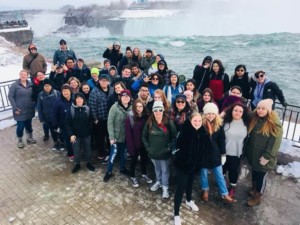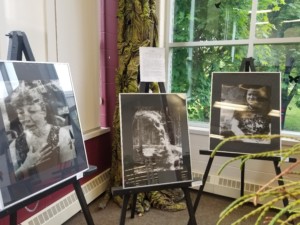July 9th, 2018
Students from Eastwood Collegiate Institute knew they were onto something big – for themselves, their school and for 20 Indigenous students from Senator Allan Bird Memorial School in northern Saskatchewan – when they set out to organize a student exchange this past spring. With support from their teachers, and funding from the federal Experiences Canada program, they planned their own “reconciliation” experiment, leveraging an existing, and very deep, interest in native studies. With the exchange now behind them, they say reconciliation is about listening and learning, and connecting person-to-person.
“It’s one thing to read about Canada’s history and its Indigenous people,” says Myah Robinson, a Grade 9 Student at Eastwood and the youngest to participate in the exchange. “But this was a real connection with real people. That’s learning!” Robinson found her initial inspiration, and experienced some shock, when she encountered Gord Downie’s Secret Path graphic novel and album about Chanie Wenjack, a twelve-year boy who tried to escape Indian Residential School fifty years ago and died of exposure on the railway tracks. Like the other students, she had to articulate her personal learning objectives and be enrolled in a native studies class to be considered for the exchange.
Things got rolling in March this year when the students from the Montreal Lake Cree Nation boarded a plane – a first flight for some – and entered the world of their “twins” in southern Ontario. A return exchange was, unfortunately, cancelled due to wild fires in Saskatchewan. There is little doubt that most of the Kitchener students will make a personal journey there at some time in the future.

Visiting Niagara Falls
After an initial flurry of interest in the food and shopping concessions at Toronto’s Pearson Airport – Tim Horton’s was a favourite – the visiting students arrived in Kitchener where they met with their twins’ families. The week ahead included classroom time, time in Toronto, Niagara Falls, St. Jacob’s, a Kitchener Rangers game, and a haunting visit to the Woodland Cultural Centre in Brantford managed by the Six Nations of the Grand River and situated beside the Mohawk Institute Indian Residential School. The school is slated for renovation and a new life as an interpretive centre in the future. A variety of community-based Indigenous organizations and educational institutions sent representatives to Eastwood during the visit too, demonstrating the depth of existing community programs and post-secondary options available locally.
It turned out that the visiting students were regular teenagers with a lot in common with their hosts. Fellow students, Maya Linsley and Joe Huggins mention that their billets shared a lot of common ground – shopping and shoes, for example.
“It was a dream come true for me when I heard that the exchange was happening,” said Maya Linsley, a buoyant Grade 10 student with a clear passion for her native studies program. Her twin was an accomplished athlete who travelled extensively.
“The visit to the Woodland Culture Centre and being on the actual grounds of a residential school was really profound for all of us,” says teacher, Adam Kasper, who noted that the difficult story of Canada’s Residential School System was recalled often during the week. “The energy near the school made it a very sad, hard place to be,” added Karen Lillie.
Kasper plays a leadership role at Eastwood where he adapts the province’s First Nation, Métis, and Inuit Education curriculum so students make a quick and deep connection to the history of Canada and its Indigenous communities. He and colleagues Karen Lillie and Greg Toller form a triumvirate of energy and inspiration about native studies at Eastwood. Toller, who used to teach in Nunavut, had originally hoped to arrange an exchange with territorial students, but Eastwood was matched with Senator Allan Bird by Experiences Canada.

A student’s photography displays in the library
Lillie has encouraged her native studies students to channel their learning into various forms of artistic expression and, eventually, action. The result has been an installation by Grade 12 students featuring visual art, website development, letter writing campaigns, traditional Indigenous ecology displays, and a beading workshop. The students’ contact with authentic Indigenous voices and content has inspired their art and questions about how they might take action themselves and how to talk to others about their new awareness. The school has proactively reached out to the City of Kitchener, for example, with a request to partner in future educational and outreach initiatives.
Experienced on land originally ceded to the Six Nations of the Grand River by the British after the American Revolutionary war, this latest exchange adds to Eastwood’s growing reputation for understanding and promoting diversity. The exchange has left the Kitchener teenagers with lifelong friends, many memories and a deeper understanding of Indigenous history and culture. Unrelated to the exchange, but demonstrative of the connection this school has made with Indigenous history, Eastwood students also mounted a Wenjack Railway Walk in the fall of 2017 with proceeds going to the “Save the Evidence” campaign that will fund restoration efforts at the Mohawk Institute Residential School.
“Truth and Reconciliation will happen and should happen, “ says Kasper. “We have to believe that. Education and learning how to talk to others about it is key.” He says a refreshed provincial curriculum for native studies is expected this fall.
In its 2015 report to Parliament, Canada’s Truth and Reconciliation Commission challenged Canadians to make amends with its Indigenous communities and learn more about the culture and history of our country’s first people. While that goal is commendable and very necessary, it is daunting for most Canadians. For students at Eastwood Collegiate, being free to ask questions and connect with their peers from Saskatchewan made all of the difference as they forged their own path to reconciliation and learning.
by Susan Wright
Categories: Learning · Well-being

